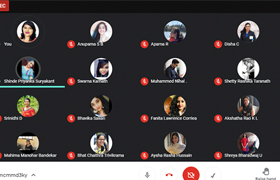Placement and Training - Sahyadrian Recruited by Diabsolut Technologies

Mr. Nathaniel Ryan Mathew from Computer Science & Engineering of 2021 outgoing batch has been offered for the ‘Associate Consultant’ role with Diabsolut Technologies.
CTC Offered is INR 4.3 LPA + 5% Bonus with 90 Days internship at Stipend of INR 25,000
Webinar on "SDN - Architecture of Future Networks"

Dept. of Electronics & Communication Engineering in association with Sahyadri Innovation Council organized a Webinar on “SDN (Software Defined Networks)”. The key note speaker was Mr. Pradeep Kumar, Assistant Professor, Dept. of Electronics & Communication Engineering.
The webinar emphasized mainly on:
• Overview and key concepts about internet
• Packet based network and its characteristics
• Network elements and key features
• Challenges faced by network operators
• Open Network Foundation initiatives
• SDN basics and architecture
• Advantages of SDN
• Ways to Contribute to evolving SDN Standards
Webinar saw participation from Faculty members and students of multidisciplinary area.
Glimpse of Online Classes held during Apr’2021
 Effective 21st April 2021, Online classes have been held and tracked on a day to day basis, department wise. Students have been engaged well and feedback has been received in order to introduce new methodologies in teaching during the pandemic times.
Effective 21st April 2021, Online classes have been held and tracked on a day to day basis, department wise. Students have been engaged well and feedback has been received in order to introduce new methodologies in teaching during the pandemic times.
Count of classes held in April’2021 is given below
| Department |
Count of classes |
| Basic Science |
53 |
| Civil Engineering |
90 |
| Computer Science & Engineering |
234 |
| Electronics & Communication Engineering |
99 |
| Information Science & Engineering |
154 |
| MBA |
132 |
| Mechanical Engineering |
116 |
Coronavirus Disease (COVID-19): Home care for families and caregivers

People with no symptoms should be able to stay at home, if adequately isolated from others, but this should be confirmed by a doctor. Those with mild or moderate disease can be considered for home care if they are under the age of 60, do not smoke, are not obese, and do not have other diseases such as cardiovascular disease, diabetes mellitus, chronic lung disease, cancer, chronic kidney disease, immunosuppression.
A health worker will assess risk factors along with the person’s symptoms, medical history and ability for the family to manage the care. Household members need to limit shared spaces, practice the recommended hygiene and know how to recognize and respond to signs of worsening health.
A trained health worker will need to assess whether the home in question is suitable for the isolation and care of a COVID-19 patient, and proper infection prevention control measures are put in place. Trained health workers are also important to support the patient and family in the home, or by phone, telemedicine, or outreach teams.
What should be done to prevent other people in the house from becoming sick if a person with COVID-19 is being cared for at home?
There are a number of precautions that can prevent the spread of COVID-19 to other people in the house:
• The ill person should stay in a separate room. If this is not possible, then keep at least a 1-metre distance from them. The sick person and anyone else in the same room should wear a medical mask.
• Provide good ventilation in the room of the ill person and shared spaces, and open windows if possible and safe to do so.
• The ill person should wear a medical mask as much as possible, in particular when not alone in the room and when at least a 1-metre distance from others cannot be maintained.
• Visitors should not be allowed in the home.
• Limit the number of caregivers to one person with no underlying conditions, if possible.
• Caregivers and household members should wear a medical mask while in the same room with an ill person, not touch their mask or face during use, discard the mask after leaving the room, and wash their hands afterward.
• The ill person should have dedicated dishes, cups, eating utensils, towels and bed linens. They should be washed with soap and water, and not shared.
• Frequently touched surfaces by the ill person should be cleaned and disinfected at least daily.
Everyone in the household should wash their hands with soap and water regularly, especially:
• after coughing or sneezing
• before, during and after you prepare food
• before eating
• after using the toilet
• before and after caring for the ill person
• when hands are visibly dirty
• A cough or sneeze should be covered with a flexed elbow or a disposable tissue that is discarded immediately after use.
• The waste from the ill person should be packed in strong closed bags before disposal.
• How long should people with COVID-19 stay at home and in isolation?
• People with COVID-19 who are cared for at home should stay in isolation until they are no longer able to transmit the virus to others:
Those with symptoms should stay isolated for a minimum of 10 days after the first day they developed symptoms, plus another 3 days after the end of symptoms – when they are without fever and without respiratory symptoms.
People without symptoms should stay isolated for a minimum of 10 days after testing positive.
Source: World Health Organization (WHO)
Quote for the day
Your time is limited, so don't waste it living someone else's life.
- Steve Jobs